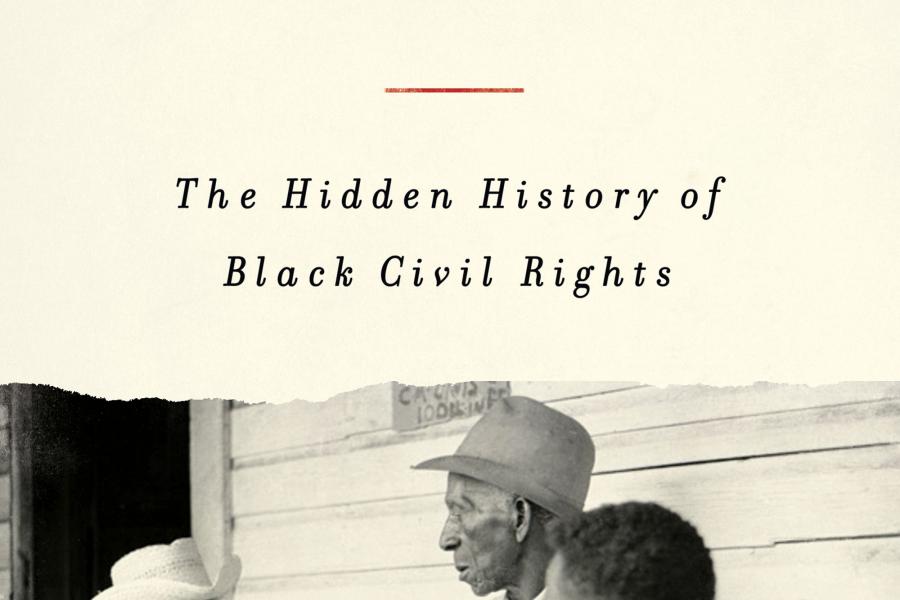
Image caption: Dylan Penningroth
Image credit: Photo by Saroyan Humphrey
For many, the story of the Civil Rights Movement begins somewhere in the 1950s, when cases like Brown v. Board of Education reached the Supreme Court docket and forever changed the landscape for African Americans in the United States. But in Before the Movement: The Hidden History of Black Civil Rights (Liveright, 2023), historian Dylan C. Penningroth, A&S '00 (PhD), pens a compelling narrative that showcases "ordinary black people [using] law in their everyday lives," as early as the 1830s, a practice that he believes paved the way for the Civil Rights Movement that was yet to come.
The quest to find out more about what Penningroth calls the "legal lives" of Black people began nearly two decades ago, when he followed the paper trail into the dusty basements and back rooms of county courthouses across the nation. There he found the lost legacies of Black people that had been tucked away and left untouched for centuries. In some cases, the details were documented in "spidery handwriting on yellow paper, trifolded and tightly packed, sometimes flaking away or chewed by mice and insects," he writes. But that didn't stop the MacArthur Fellow from digging deeper. He wanted to write and read a history book where Black people were at the center. "The freedom struggle narrative has always been dominant. There's a whole other world that we need to be talking about," he says.
So, he combed through more than 14,000 overlooked civil cases from two dozen courthouses in five states and the District of Columbia. While race was indicated on most things back then, it was somehow left off many of the legal documents stowed away from centuries ago. That meant the legal scholar would have to look up the race of each person mentioned in the case using U.S. Census Bureau data preserved on microfilm, which proved to be a time-consuming process—one that could take up to 30 minutes per person. With the help of his graduate students, he was able to identify more than 1,500 cases that involved Black people. From there he was able to piece together their stories, which provide a detailed backdrop for American law and history.
While most of history paints a dismal picture of African Americans and the law, those who understood it were using the laws to protect themselves, their families, and their properties, from the time of slavery up until the Civil Rights Movement. And others were using it to be petty, get even, and find freedom. Some legal matters involved whites, "but the large majority of lawsuits were against other Black people. They sued over everything: divorce, slander, contracts to buy land, job disputes, and personal injury." No different from today, some cases got ugly.
Even with limited education and resources at the time, slaves were keenly aware of the law—and they used it to secure their futures whenever they had the opportunity. While many had verbal agreements and handshakes, they also wrote IOUs on the back of store receipts, voted in new church trustees, and lent mules to neighbors. Others acquired deeds to land, filed for divorces, and incorporated businesses and churches, giving Black people some of the first opportunities to lead and control their own affairs. Signatures were needed, bylaws had to be written, and rules had to be followed. "Freedpeople wanted to know what was in the contract because they understood, perhaps better than white people, that … a contract was binding and there was no obvious difference between the bondage of a contract and the bondage of slavery, between the coercion of a sheriff and the coercion of a master," he explains.
Also see
This story became personal for Penningroth. When he was just 5 years old, his uncle recorded an interview with his great-uncle Thomas Holcomb shortly before his death. In the recording, Holcomb explained that his father, Jackson Holcomb, had a boat in the 1860s, and that one day, after a battle, he ferried Confederate soldiers across the Appomattox River, and that the soldiers paid him. "He made a deal. I'll take you across and you'll pay me," Penningroth says. If his ancestors were chartering boats during the war and being paid for it, they had to be negotiating other deals as well. This led him to begin his research.
Beyond his lineage, Penningroth digs into the business of other Black folk whose stories have been quietly tucked away in ledgers and books nearly forgotten. There are stories of love, betrayal, freedom, and success. The bonds of slavery nonetheless yielded men and women who were intelligent enough to protect their interests to the fullest extent that they could at the time. With Before the Movement, Penningroth uncovers the rich histories and storied tales that did not make the headlines of newspapers, the un-Googleable facts of generations that were never typed onto the wall of the internet.
Posted in Politics+Society








